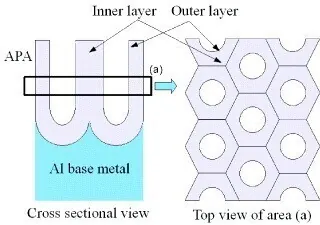
How Nanostructured Alumina is Revolutionizing Antibacterial Practices in Cell Culture
2025-01-12
Author: Nur
Introduction
Researchers from Tokyo Metropolitan University (TMU) have achieved a groundbreaking development in the field of cell culture by creating nanostructured alumina surfaces that exhibit remarkable antibacterial resistance, promoting healthier growth of cultured cells. This innovative technology is set to change the landscape of biomedicine, making it possible to culture cells without the constant worry of bacterial contamination.
Development of Nanostructured Surfaces
The team, led by Professor Takashi Yanagishita, utilized advanced electrochemical techniques combined with concentrated sulfuric acid to fabricate anodic porous alumina (APA) surfaces. These surfaces prevent bacterial growth effectively without compromising the viability of the cultured cells, offering a safer and antibiotic-free environment for biological research and applications.
Challenges of Traditional Methods
Traditional methods of preventing bacterial contamination, which typically involve the use of antibiotics and harsh chemicals, pose numerous downsides, such as environmental damage and health risks associated with antibiotic resistance. As the world grapples with the rise of superbugs, the need for sustainable and innovative antibacterial solutions is more crucial than ever. The development of materials like nanostructured alumina not only addresses these needs but also provides an eco-friendly alternative.
Nature-Inspired Design
Interestingly, the inspiration for these advanced materials comes from nature itself. Early research revealed that the unique nanostructures found on the wings of cicadas and dragonflies exhibit extraordinary antibacterial properties. These natural structures hinder bacterial growth by physically disrupting the integrity of bacterial cell membranes. Scientists have sought to mimic these patterns, culminating in the creation of nanostructured surfaces that mimic nature's defenses.
Features of APA Surfaces
The APA surfaces developed at TMU feature a highly ordered array of needle-like porous structures designed to eliminate bacteria while remaining safe for cell culture. These surfaces, when exposed to concentrated sulfuric acid, demonstrated significantly improved antibacterial performance compared to other treatments, all while being non-toxic to the biological cells grown upon them.
Implications for Cell Culture and Regenerative Medicine
Historically, antibiotics have been a staple in cell culture media to impede bacterial contamination, but their use is fraught with challenges, including ineffectiveness against resistant strains. The introduction of APA surfaces addresses these challenges and eliminates the reliance on such additives, heralding a new era for cell culture environments.
This advancement is especially promising in the realm of regenerative medicine, where cultured cells are grown for therapeutic applications to repair damaged tissues or organs. The risks associated with bacterial contamination can be particularly detrimental for patients with weakened immune systems. The use of APA surfaces could enable the research and cultivation of cells in more varied settings without needing highly sterilized environments, thus broadening the accessibility and application of scientific inquiry.
Conclusion
Overall, the implications of this research extend far beyond basic cell culture. By paving the way for antibiotic-free practices in laboratories, this groundbreaking technology could ultimately transform patient treatment protocols, enhance the safety of scientific experiments, and contribute significantly to the future of regenerative medicine.
As this innovative technology continues to develop, the potential for more sustainable practices in medicine remains promising, representing a leap forward in combating bacterial pathogens effectively.




 Brasil (PT)
Brasil (PT)
 Canada (EN)
Canada (EN)
 Chile (ES)
Chile (ES)
 Česko (CS)
Česko (CS)
 대한민국 (KO)
대한민국 (KO)
 España (ES)
España (ES)
 France (FR)
France (FR)
 Hong Kong (EN)
Hong Kong (EN)
 Italia (IT)
Italia (IT)
 日本 (JA)
日本 (JA)
 Magyarország (HU)
Magyarország (HU)
 Norge (NO)
Norge (NO)
 Polska (PL)
Polska (PL)
 Schweiz (DE)
Schweiz (DE)
 Singapore (EN)
Singapore (EN)
 Sverige (SV)
Sverige (SV)
 Suomi (FI)
Suomi (FI)
 Türkiye (TR)
Türkiye (TR)
 الإمارات العربية المتحدة (AR)
الإمارات العربية المتحدة (AR)